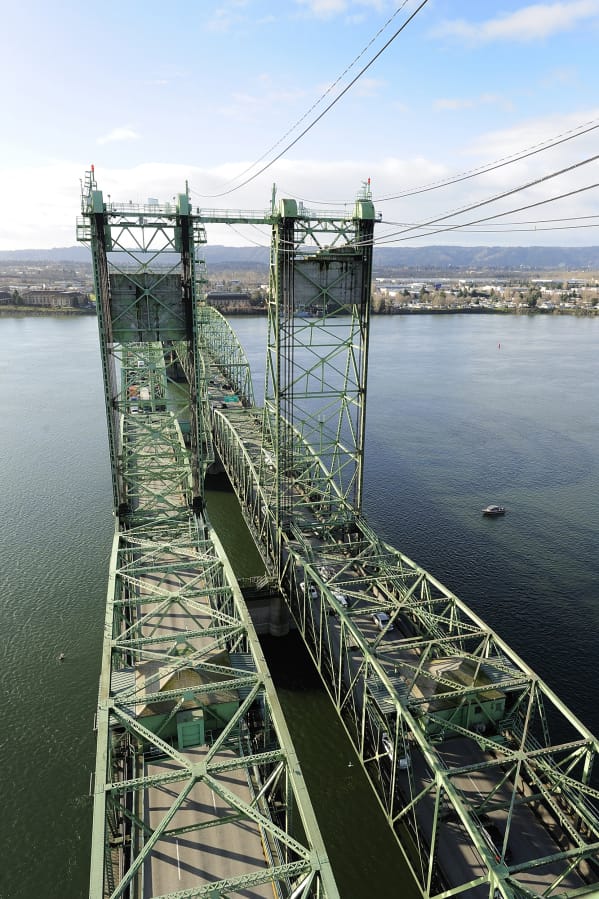For anyone obsessed with the upcoming closure of the Interstate 5 Bridge’s northbound span, set your countdown clock for 212 days.
That’s how long until the span, which opened 103 years ago, shuts down for up to nine days, starting Sept. 12 and ending Sept. 20.
The closure is to replace two trunnions, part of the drawbridge’s lifting mechanism that allows tall vessels to pass under the green structure. The work will replace sheaves, or wheels about 12 feet in diameter, sheave covers, cables and trunnions, which are axles 20 inches in diameter that help lift and lower the bridge.
In 1999, a crack was found in the east trunnion on the northbound bridge’s south tower, just two years after the span was shut down in September 1997 to replace the other two trunnions.
During this year’s work, the northbound span will be closed to vehicles, pedestrians and bicyclists.
All vehicular traffic will be switched to the three-lane southbound span. As was the case with the 1997 closure, a movable “zipper” barrier will create two travel lanes to accommodate rush-hour traffic into Portland in the morning and two lanes for the afternoon commute to Clark County. The barrier will be moved at 2 a.m. before the morning commute begins and at noon before afternoon rush hour starts.
The 1997 closure went fairly smoothly, and traffic congestion wasn’t nearly as bad as projected. Drivers diverted to the Interstate 205 Bridge, used transit and temporary commuter rail, worked from home and cut back or eliminated discretionary travel. Financial incentives spurred the contractor to finish what could have been a three-week project in just six days.
This year’s closure likely won’t be so smooth, primarily due to growth in Clark County. Since the September 1997 project, the county’s population has increased by about 175,000.
“I seriously doubt we will see a replay,” said Ryan Lopossa, Vancouver’s streets and transportation manager. “There are just so many people who make that crossing.”
If drivers do not change their travel habits, estimates indicate that backups could stretch for 4 miles on either side of the Columbia River, and the duration of congestion could nearly triple, from seven to 20 hours a day.
ODOT spokeswoman Kimberly Dinwiddie didn’t downplay disruption from shutting down the northbound span for nine days.
“We realize that this is going to be hard for people,” she said. “It is going to affect people’s lives, and not everyone can change the way they get to work.”
ODOT’s experience during summer 2018, when ramps were shut down at I-5 and Interstate 84 in Portland for up to two weeks, gives her hope that effective outreach will convince people to change their driving habits and prevent monstrous traffic jams.
“The public should take a lot of credit for how well things went in 1997,” Dinwiddie said. “And we are confident that travelers can again make this bridge closure a success.”
The closure is scheduled for September because of lower vehicle counts on the bridge and lower water levels in the Columbia River, which means more vessels will be able to pass under the bridge’s distinctive hump without a bridge lift.
In August 2018, about 141,600 vehicles a day used the bridge. Traffic volumes fell by about 4 percent, to 136,000, in September 2018.
“It’s common to see our traffic volumes decrease in September when students are back in school,” Dinwiddie said.
ODOT didn’t have traffic volumes broken down by month for 1997. Over the course of the year, the bridge averaged about 114,600 vehicles a day. Since then, bridge traffic has increased by about 18 percent.
Contractor on board
ODOT already has hired a contractor, Hamilton Construction Co. of Springfield, Ore. Unlike most contracts, ODOT selected Hamilton based on the company’s ability to handle the entire project, including traffic management and component fabrication, not for its dollar bid, Dinwiddie said.
“They are responsible for everything,” she said. “ODOT manages their work. They are responsible for delivering the final product and managing all subcontractors.”
Replacement components — trunnions, sheaves, sheave hoods and cables — are being fabricated at G&G Steel Inc. in Russellville, Ala., and should arrive here in August.
Hamilton’s $7.9 million contact with ODOT includes a $150,000 incentive for each day it finishes early, up to a maximum of $600,000. That means if the contractor wants to earn the maximum incentive, it needs to finish in five days, so the northbound span would open to traffic on Sept. 17.
Conversely, the contract contains a $150,000 daily penalty if construction lasts longer than nine days. Unlike the incentive, there is no maximum for financial penalties Hamilton will pay if it doesn’t finish on time.
Overall, the project is expected to cost $10 million, with Oregon and Washington splitting the cost.
Even if this year’s trunnion work goes smoothly, commuters can expect more morning congestion headaches into Portland. ODOT intends to replace the barrier along the east side of the southbound bridge, which will require closing the far left lane to vehicles around the clock for the week following the trunnion work.
Dinwiddie said construction will take a week because concrete for the barrier is poured in place. Crews will need to demolish the existing barrier, build forms, pour the concrete and let it cure for a few days, she said.
Transit
Both C-Tran and the city of Vancouver are gearing up for the closing. Christine Selk, C-Tran’s communication and public affairs manager, said her agency is working closely with the Washington State Department of Transportation to complete a project so buses can run on the left shoulder of I-5 southbound, from 99th Street south to the bridge.
Dinwiddie said ODOT intends to allow C-Tran to operate buses on the southbound shoulder of the I-205 Bridge, from Highway 14 to Airport Way.
There has been some talk of providing C-Tran with additional buses, but Selk said that probably won’t happen. C-Tran is planning for longer run times for buses traveling to and from Portland because of congestion during the closure.
“We will have about eight spare buses in place every day that we can insert into the schedule to help pick up the slack,” Selk said.
There have been some informal discussions about creating a temporary Park & Ride lot at the Bonneville Power Administration’s Ross Complex, but nothing has been finalized, she said.
C-Tran is encouraging people to ride transit, carpool, delay trips, flex their work schedule, work from home or take other steps to reduce congestion, Selk said.
One possibility is C-Tran’s Vanpool program for people who work at locations clustered together. A group of five to 12 people share a van that C-Tran owns, maintains and insures and one of the commuters drives. Vanpool riders pay a monthly fare, based on the number of miles traveled and number of riders.
“Vanpool is part of the larger ride share puzzle,” Selk said.
City streets
During the bridge closure, four freeways’ ramps will be closed:
- I-5 north offramp to state Highway 14 eastbound.
- Highway 14/Washington Street onramp to I-5 south.
- Marine Drive onramp to I-5 north in Portland.
- Hayden Island onramp to I-5 north in Portland.
The Washington Street and Marine Drive ramps will be open to buses only.
The trunnion fix could have a big effect on Vancouver streets as traffic diverts off the freeway or heads east to the I-205 Bridge.
Lopossa, Vancouver’s streets and transportation manager, said ODOT and the Washington State Department of Transportation will put together a traffic management plan for the trunnion closure.
“That guide is sort of the playbook for how everything is supposed to work,” he said.
Because of the closure of the Washington Street/Highway 14 onramp, Vancouver intends to detour traffic north on Columbia Street and then east on Mill Plain Boulevard to the freeway, Lopossa said.
The city will adjust traffic signals to better move that traffic, as well as at other locations as needed, he said.
“We recognize that with the best-laid plan, there is always something that is going to need to be tweaked when we go live,” he said.
Commuter rail
There is still no decision on whether temporary commuter rail will be available during the trunnion work.
Free commuter rail was provided during the 1997 project, thanks to $225,000 in grants from the two state transportation departments. Vancouver created a temporary parking lot for 1,000 cars and offered shuttles to the Amtrak depot, which has limited parking.
Officials say equipment shortages, in part because of the December 2017 derailment of an Amtrak Cascades train near DuPont, could make it difficult to come up with the equipment to provide commuter rail.
An Amtrak Cascades train derailed after entering a sharp curve at nearly 80 mph and train cars tumbled off an overpass onto I-5. Three people were killed and 65 injured. That crash took one locomotive and train set — rail cars for passengers, business-class travelers, baggage, and food and beverage — out of service.
“It’s a little soon to tell,” Dinwiddie said. “If equipment is secured, then we could plan for additional service during the I-5 Bridge closure.”




